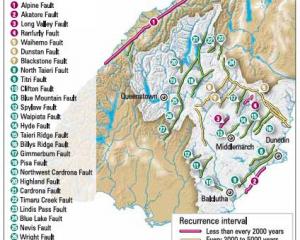The Earthquake Commission (EQC) has received 223 claims for damage following last night's 7.8 magnitude earthquake.
More were expected in the coming weeks and months as minor damage was reported, including cracks to wallpaper, bricks and house exteriors, EQC spokesman Lance Dixon told NZPA.
Most of the claims were lodged in Invercargill, Dunedin and around Otago, but some came from as far away as Christchurch and Greymouth.
People had up to three months to lodge claims, and could do so on the Earthquake Commission's 24 hour line, 0800 DAMAGE, or online at www.eqc.govt.nz.
The commission only covers insured residential property.
Last night's quake, centred 100km northwest of Tuatapere and 12km deep, struck at 9.22pm and triggered an alert from the Pacific tsunami warning centre in Hawaii.
The tsunami warning was cancelled after only two small waves were recorded about 10.30pm -- a 30cm wave at Dog Island near Bluff and a 17cm wave at Jackson's Bay on the Fiordland coast.
The quake was felt widely throughout the South Island and as far north as Taranaki, and was followed by two sizeable aftershocks, one 19 minutes after the initial quake measuring 6.1, and another at 1.50am measuring 5.9.
Four more strong aftershocks followed this afternoon.
The first, measuring 5.3, hit Fiordland at 12.24pm. Another tremor, measuring 5.6, was felt 20 minutes later, followed by a 5.1 quake at 1.30pm.
The latest, at 2.13pm, measured 5.1 and was at a depth of 12km, 80km west of Te Anau.
GNS Science said the aftershocks were felt in Alexandra and Invercargill.
A separate 5.4 magnitude quake in Taranaki at 9.38pm yesterday was not thought to be linked to the Fiordland quake, GNS geologist Matthew Stevens said today.
DOC staff flew into Fiordland National Park at first light to check on registered trampers and one-day visitor structures before focusing on the quake's epicentre and surrounding huts and tracks, Te Anau acting area manager Andrew Cudby said.
The trampers were leaving the park on foot and were expected out at some stage today, Mr Cudby said.
There had been some slips but no major damage, and the ground would be monitored over coming months.
Visitors to the park should report any ground or slip concerns, he said.
DOC staff in the field had been contacted and were unharmed.
The controller of Southland's civil defence emergency management group, Neil Cruickshank, activated the region's emergency operations centre to assess damage reports and said the region had been given "a good shake" .
"Phone services were down in east Invercargill and power was out for some time in the suburb of Otatara because of the earthquake," he said.
Civil Defence staff flew over the epicentre today but found little damage.
They would continue to monitor and assess the aftermath, he said.
Mr Cruickshank said anyone worried about the structural integrity of their building should contact their local council.
More than 14,000 earthquakes are recorded in New Zealand annually, but only about 20 are stronger than 5 on the Richter scale.
The Inangahua earthquake on the West Coast in 1968 measured 7.1 and killed three people.
The previous strongest recorded Fiordland earthquake, near the mouth of Doubtful Sound in August 2003, measured 7.1 and caused considerable damage in Te Anau.
The Earthquake Commission received almost 3000 claims totalling $10.5 million.




